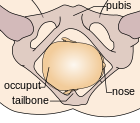Cephalic presentation
| Cephalic presentation | |
|---|---|
 | |
| Vertex presentation, occiput anterior, William Smellie, 1792 | |
| Specialty | Obstetrics |
A cephalic presentation or head presentation or head-first presentation is a situation at
Engagement
The movement of the fetus to cephalic presentation is called head engagement. It occurs in the
Classification
In the vertex presentation, the head is
Non-cephalic presentations are the
Vertex presentation
The vertex is the area of the vault bounded anteriorly by the anterior fontanelle and the coronal suture, posteriorly by the posterior fontanelle and the lambdoid suture and laterally by 2 lines passing through the parietal eminences.
In the vertex presentation, the occiput typically is anterior and thus in an optimal position to negotiate the
The vertex presentations are further classified according to the position of the occiput, both right, left, or transverse and anterior or posterior:
- Left Occipito-Anterior (LOA), Left Occipito-Posterior (LOP), Left Occipito-Transverse (LOT)
- Right Occipito-Anterior (ROA), Right Occipito-Posterior (ROP), Right Occipito-Transverse (ROT)
The occipito-anterior position is ideal for birth; it means that the baby is lined up so as to fit through the pelvis as easily as possible. The baby is head down, facing the spine, with their back anterior. In this position, the baby's chin is tucked onto their chest, so that the smallest part of their head will be applied to the cervix first. The position is usually "Left Occiput Anterior", or LOA. Occasionally, the baby may be "Right Occiput Anterior", or ROA.[5]
Face presentation

Factors that predispose to face presentation are
Face presentations are classified according to the position of the chin (mentum):
- Left Mento-Anterior (LMA), Left Mento-Posterior (LMP), Left Mento-Transverse (LMT)
- Right Mento-Anterior (RMA), Right Mento-Posterior (RMP), Right Mento-Transverse (RMT)
Brow presentation
While some consider the brow presentation as an intermediate stage towards the face presentation,
Reasons for predominance
The piriform (pear-shaped) morphology of the uterus has been given as the major cause for the finding that most singletons favor the cephalic presentation at term.[1] The fundus is larger and thus a fetus will adapt its position so that the bulkier and more movable podalic pole makes use of it, while the head moves to the opposite site. Factors that influence this positioning include the gestational age (earlier in gestation breech presentations are more common as the head is relatively bigger), size of the head, malformations, amount of amniotic fluid, presence of multiple gestations, presence of tumors, and others.
Two-thirds of all vertex presentations are LOA, possibly because of the asymmetry created by the descending
Diagnosis
Usually performing the
Management
Many factors determine the optimal way to deliver a baby. A vertex presentation is the ideal situation for a vaginal birth, although occiput posterior positions tend to proceed more slowly, often requiring intervention in the form of forceps, vacuum extraction, or caesarean section.[4] In a large study, a majority of brow presentations were delivered by caesarean section, however, because of 'postmaturity', factors other than labour dynamics may have played a role.[9] Most face presentations can be delivered vaginally as long as the chin is anterior; there is no increase in fetal or maternal mortality.[11] Mento-posterior positions cannot be delivered vaginally in most cases (unless rotated) and are candidates for caesarean section in contemporary management.[11]
References
- ^ a b c d e f Hellman LM, Pritchard JA. Williams Obstetrics, 14th edition. Appleton-Century-Crofts (1971) Library of Congress Catalogue Card Number 73-133179. pp. 322–2.
- ^ "Starting labour". pregnancy-bliss.co.uk. Retrieved 14 January 2009.
- ^ "Lightening During Pregnancy as an Early Sign of Labor". Giving Birth Naturally. Retrieved 22 August 2010.
- ^ PMID 7975796.
- ^ "Optimum Foetal Positioning". Homebirth.org.
- S2CID 6986584.
- ^ PMID 7005774.
- PMID 7352081.
- ^ PMID 15512065.
- PMID 8240620.
- ^ PMID 16630740.









